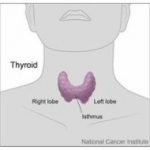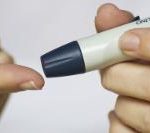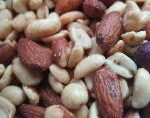Endocrine Insights – October 2019
Endocrine Insights
by Denise Armellini, MD
 Association of RAI treatment with cancer mortality in patients with hyperthyroidism
Association of RAI treatment with cancer mortality in patients with hyperthyroidism
This study included 18,805 patients treated for hyperthyroidism (Graves disease and toxic adenoma).
Radioactive iodine (RAI) therapy has been available for the treatment of hyperthyroidism since the 1940s. It is well known that higher doses>400 Mci have been linked to an increased risk for cancer, while low doses typically used to treat hyperthyroidism (5-20 mCi) result in minimal, if any, increased cancer risk.
The Cooperative Thyrotoxicosis Therapy follow-up study (CTTFS) followed >35,000 patients in the US and the United Kingdom between the years 1946 – 1964 who were diagnosed with hyperthyroidism and treated with small doses of radioactive iodine therapy. In 1998, data from the study suggested that RAI therapy was not associated with an increased risk of cancer. The authors extended the analysis to include an additional 24 years of patient follow-up. Of the 18,805 patients analyzed, average age 49, 78% were female and 93.7% had Graves disease, treated with an average dose of iodine of 10.1 mCi – 17.6 mCi. The average follow up was 26 years.
The study showed a statistically significant dose-response relationship for death from breast cancer (12% increased risk) and from all solid cancers combined (5% increased risk). The authors estimated that 14% of breast cancer deaths and 7% of all solid cancer deaths were attributed to radioactive iodine exposure in this group. No increased risk for death from leukemia, non–Hodgkin’s lymphoma, multiple myeloma or thyroid cancer was reported.
My perspective. Overall, the study pointed to an increased risk of some solid cancers after radioactive iodine therapy which was not shown in previous studies. However, additional studies are needed to confirm these findings and to help clarify the risks/benefits associated with low-dose radioactive iodine therapy for hyperthyroidism.
Menopause increases atherosclerotic CVD risk for women with type 1 Diabetes
Keshawarz A, et al. Diabetes Care. 2019
There have been few studies that address cardiovascular risk for women with type 1 diabetes as they transition into menopause.
Keshawarz and colleagues looked at data from 311 premenopausal women with type 1 diabetes (average age 34) and 325 premenopausal women without the condition (average age 36) who participated in the Coronary Artery Calcification in Type 1 Diabetes study (CACT1).
These patients were followed for 18 years.
Parameters assessed included coronary artery calcium, blood pressure, waist circumference, HDL (known as ‘good’ cholesterol), LD (known as ‘bad’ cholesterol), triglycerides, and estimated glomerular filtration rate. Cardiovascular risk and body mass index (BMI) was calculated at baseline, 3 years, 6 years and 14 years.
Among the participants with type 1 diabetes, 24% were postmenopausal after 18 years while 30% of participants without diabetes were postmenopausal. For both groups, menopause began at approximately age 50.
Researchers found a statistically significant interaction between type 1 diabetes and menopause with coronary artery calcium volume: risk was 2.7% higher in the postmenopausal diabetic group compared to 1.5% in the premenopausal diabetic group. In the non-diabetic group, premenopausal woman had a risk of 1.3% and in postmenopausal woman the risk was 1.7%
My perspective. It will be key to further examine how gender-specific factors may affect cardiovascular risk in those with diabetes and identify treatments to help modify and minimize this risk.
 Changes in nut consumption influence long-term weight change in US men and women
Changes in nut consumption influence long-term weight change in US men and women
Xiaoran Liu, Yanping Li, Marta Guasch-Ferré, Walter C Willett, Jean-Philipp Drouin-Chartier, Shilpa N Bhupathiraju and Deirdre K Tobias
This study included nearly 27,521 men, 61,680 women and 55,684 younger women who were healthy with no chronic conditions at the baseline of the study. The researchers evaluated the association between changes in nut consumption over 4-year intervals and changes in weight over 20 to 24 years. Results showed that increasing the intake of nuts, walnuts and other tree nuts by 0.5 servings/day was associated with a lower risk of obesity and lower risk of weight gain >2-5 kg.
Researchers noted that because most of the patients were Caucasian health professionals with higher socioeconomic status, the study may not be valid in other populations.
My perspective. Just a handful of nuts may help keep us from packing on the pounds as we age.
Benefits of Listening to Music
One last note – I also want to share a fascinating non-endocrine article describing how music can positively stimulate our emotions, inspiring and motivating us, adding meaning to moments and enabling us to remain connected to important memories and to one another. Please check out this article on music’s many health benefits. Click here for more information.


Wow this is great info!
Thank you, Dr. A!
I really appreciate your doing this newsletter. I have a question/comment regarding your statement, “Overall, the study pointed to an increased risk of some solid cancers after radioactive iodine therapy which was not shown in previous studies.” Does this refer to RAI with doses higher than >400 Mci, or does it refer to doses in the 5-20 mCi range? How does a patient find out what her RAI dose was after 12 years since treatment? Do hospitals generally keep records this long?
Hi Frances, good questions. This relates to low dose therapy which is between 5 to 20 mCi. Usually, Graves disease or toxic nodule conditions does not require therapy with higher doses.
The records from hospitals are usually kept for about 5-10 years approximately. This was a large database of patients and records were traced from the National Death Index, Social Security Administration and other resources. After some exclusions, about 18805 patients who received radioactive iodine therapy and had no history of cancer at the time of the first treatment were included in this analysis.
Hope this helps.
Best,
Dr. Armellini